Friday☕️

Economics & Markets:
- Yesterday’s U.S. stock market:

- Today’s commodity market:

- Today’s crypto market:
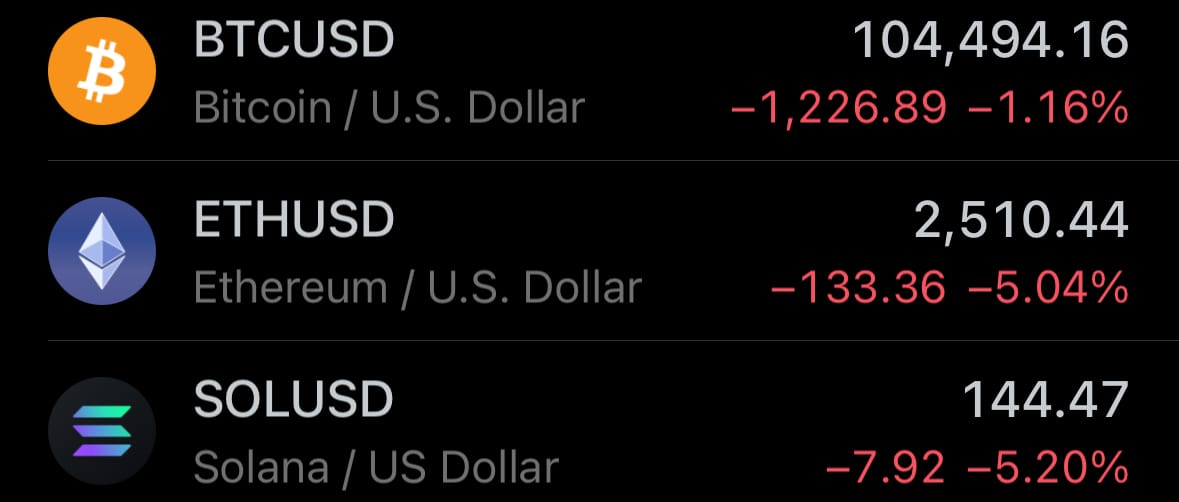
Geopolitics & Military Activity:
- Yesterday, June 12, 2025, Israel conducted Operation Rising Lion, launching airstrikes on Iran’s nuclear and military facilities, including the Natanz nuclear site in Isfahan province. Iran’s Atomic Energy Chief reported significant damage to Natanz, with the Iranian Atomic Agency stating that the facility’s nuclear reactor was destroyed. The strikes also targeted military bases and missile storage sites in cities such as Tehran, Tabriz, and Kermanshah, aiming to disrupt Iran’s nuclear program and missile capabilities. Iranian sources indicated that contact was lost with the IRGC intelligence chief, with concerns that the official and other commanders may have been killed. Israel’s government described the operation as a necessary action to counter a potential threat, focusing on infrastructure and personnel linked to Iran’s nuclear activities.
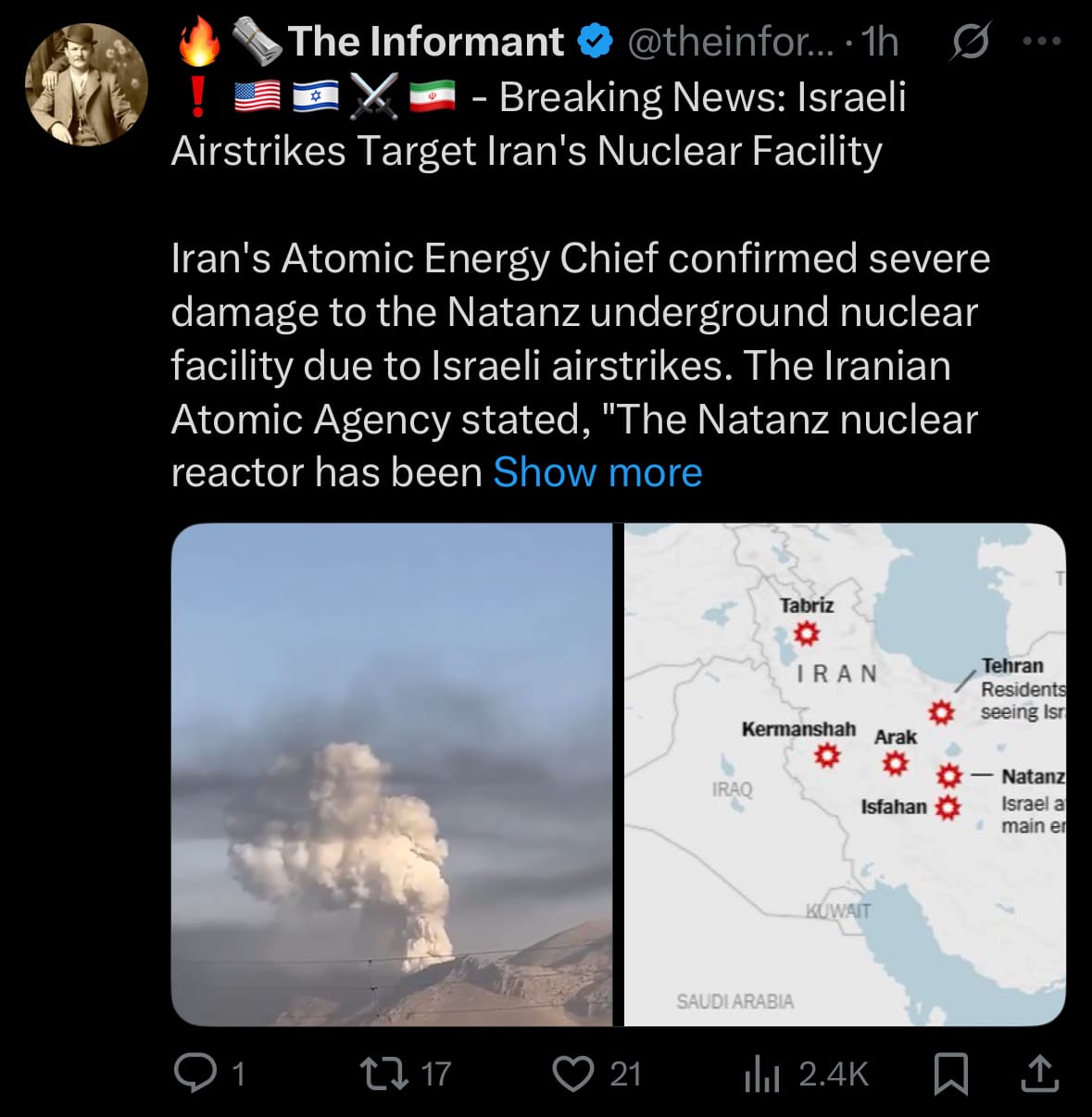
- The Natanz facility, a key site for Iran’s uranium enrichment with thousands of centrifuges in its underground Fuel Enrichment Plant, was designed to withstand attacks, though reports confirmed visible damage, including fires. The Kermanshah missile base, located in the Zagros Mountains near the Iraqi border and managed by the IRGC Aerospace Force, is a major hub for Iran’s ballistic missile storage and launches. The strikes on these sites have heightened regional tensions, with Iran promising a response and the International Atomic Energy Agency monitoring Natanz for radiation risks. Operation Rising Lion represents a significant escalation in the Israel-Iran conflict, targeting critical military and nuclear assets and drawing international focus to the ongoing rivalry.

Environment & Weather:
- A G3 (Strong) Geomagnetic Storm Warning has been issued by NOAA’s Space Weather Prediction Center, effective until 06:00 UTC (2:00 AM EDT) on June 13, 2025, due to ongoing Coronal Mass Ejection (CME) activity. A CME is a large release of solar plasma and magnetic fields from the Sun that can disturb Earth’s magnetic field when it reaches our planet. The G3 level, on a scale from G1 (Minor) to G5 (Extreme), indicates a strong storm that may impact power grids, satellites, and radio communications, especially in regions closer to the poles. For example, it could cause minor voltage issues in power systems, affect satellite navigation like GPS, or disrupt high-frequency radio signals. Earlier, at 00:29 UTC (8:29 PM EDT on June 12), a G2 (Moderate) storm was observed, showing that the geomagnetic activity has been intensifying. This storm is driven by the CME’s interaction with Earth’s magnetic field, which is strengthened when the solar wind’s magnetic orientation aligns in a specific way.
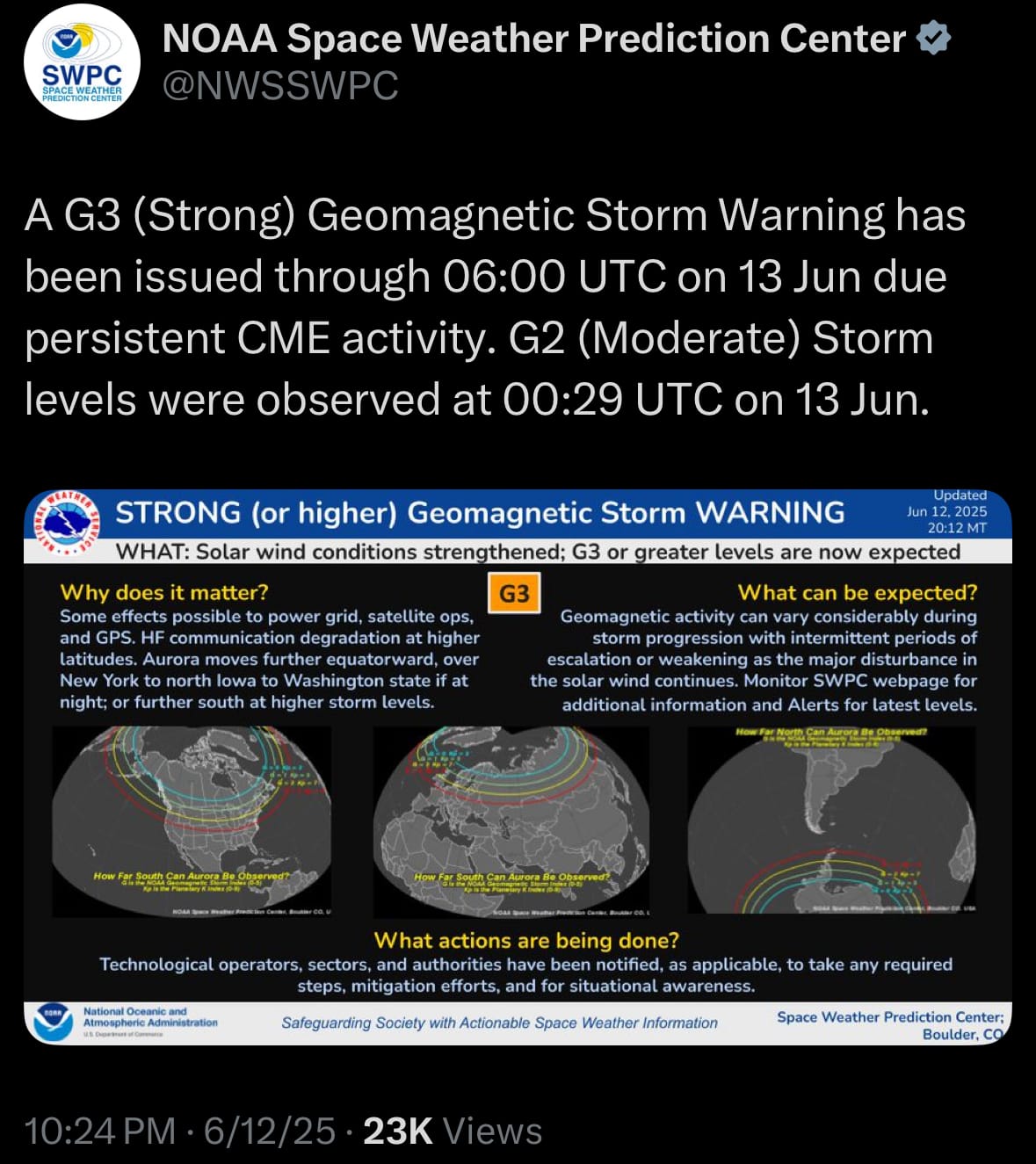
- This G3 storm may create challenges but also offers a chance to witness vibrant auroras, potentially visible in mid-latitude areas like parts of the northern United States or Europe. The storm’s effects are expected to continue, with a G2 Watch issued for June 14, 2025, suggesting further geomagnetic activity, possibly influenced by additional solar wind streams. While strong storms can cause minor disruptions, modern systems like power grids and satellites are designed with protections to reduce risks. The event is part of the Sun’s natural 11-year cycle, which is currently in an active phase, leading to more frequent solar flares and CMEs in 2025. Authorities and industries are monitoring the situation to manage any potential impacts effectively.

Space:
- Yesterday, June 12, 2025, SpaceX launched the Starlink Group 15-6 mission from Space Launch Complex 4 East at Vandenberg Space Force Base in California. A Falcon 9 Block 5 rocket carried 26 Starlink satellites into low-Earth orbit. The satellites aim to expand the Starlink constellation for global internet access. The first stage booster, B1081-15, landed successfully on a droneship 594 km downrange. The mission also included fairing recovery 664 km downrange, showcasing SpaceX’s reusable rocket technology.
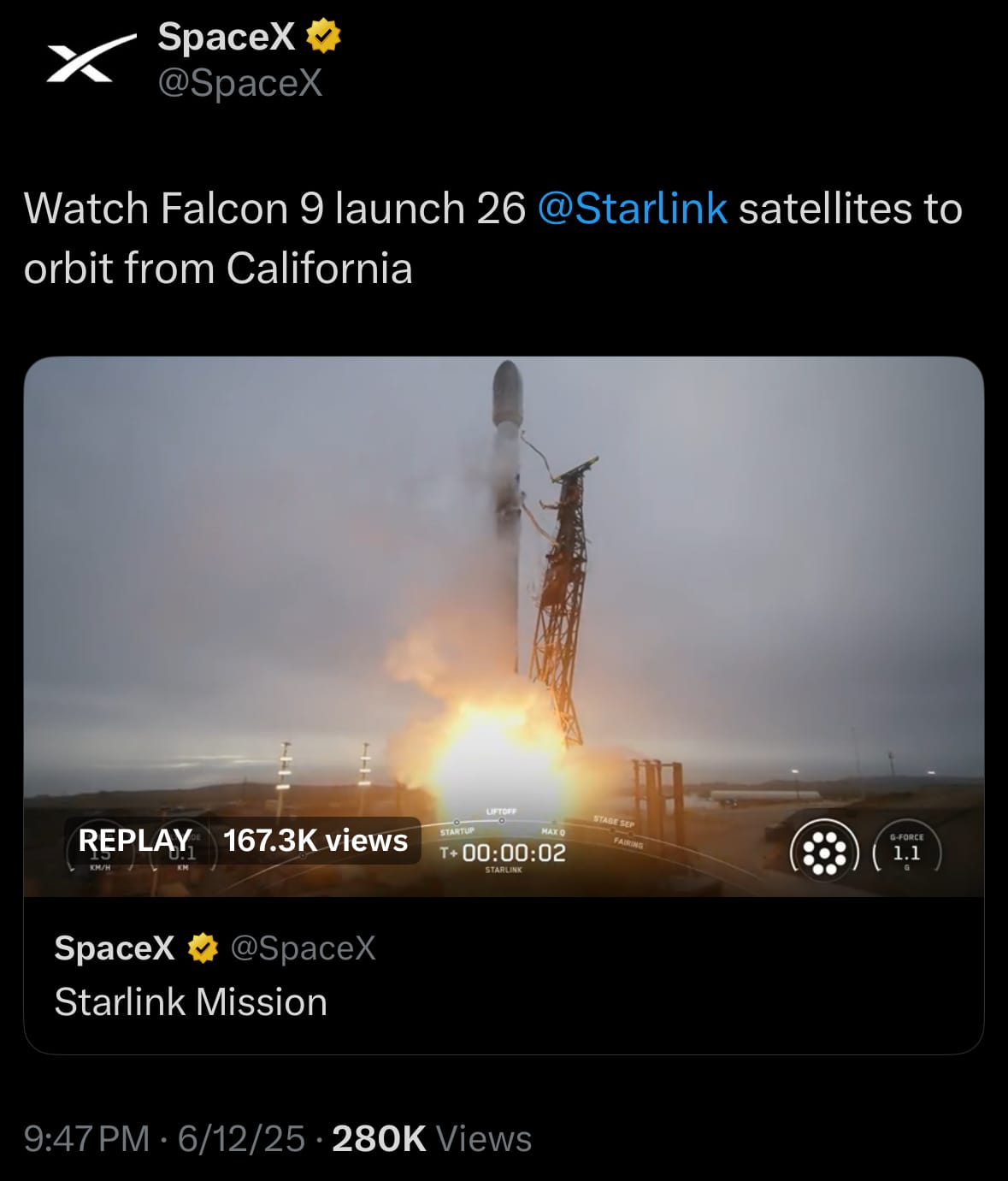
- Vandenberg Space Force Base, established in 1941 as Camp Cooke, has a long history as a key U.S. spaceport. Initially an Army training ground, it transitioned to an Air Force base in 1957 and was renamed Vandenberg in 1958. The base became a critical site for missile testing and space launches, with its first satellite launch in 1959. Its polar orbit capabilities, ideal for satellites like Starlink, made it a cornerstone of U.S. space operations. Over decades, Vandenberg has supported thousands of launches, including military, NASA, and commercial missions. Since SpaceX began using Vandenberg’s SLC-4E in 2013, the base has been pivotal for Starlink and other commercial launches, cementing its role in modern space exploration.
Statistic:
- Largest public semiconductor companies by market capitalization:
- 🇺🇸 NVIDIA: $3.536T
- 🇺🇸 Broadcom: $1.204T
- 🇹🇼 TSMC: $1.117T
- 🇳🇱 ASML: $309.13B
- 🇰🇷 Samsung: $279.37B
- 🇺🇸 AMD: $192.13B
- 🇺🇸 Texas Instruments: $181.38B
- 🇺🇸 QUALCOMM: $174.25B
- 🇬🇧 Arm Holdings: $146.83B
- 🇺🇸 Applied Materials: $140.43B
- 🇺🇸 Micron Technology: $129.83B
- 🇰🇷 SK Hynix: $119.26B
- 🇺🇸 Lam Research: $117.24B
- 🇺🇸 KLA: $115.71B
- 🇺🇸 Analog Devices: $115.18B
- 🇺🇸 Intel: $90.59B
- 🇺🇸 Synopsys: $76.80B
- 🇯🇵 Tokyo Electron: $75.58B
- 🇹🇼 MediaTek: $67.88B
- 🇺🇸 Marvell Technology: $60.04B
- 🇳🇱 NXP Semiconductors: $54.92B
- 🇩🇪 Infineon: $53.38B
- 🇨🇳 SMIC: $52.79B
- 🇯🇵 Advantest: $43.27B
- 🇺🇸 Microchip Technology: $36.64B
History:
- The origins of refrigeration trace back to ancient civilizations, where natural cooling methods were employed to preserve food. Around 1000 BC, the Chinese used ice cellars—insulated underground chambers—to store perishable goods, harvesting ice from frozen rivers during winter. Similarly, the Greeks and Romans around 500 BC transported snow from mountains, packing it in straw or burying it in pits to maintain cool temperatures for food and drink storage. In Persia, by 400 BC, sophisticated evaporative cooling systems called yakhchāls were developed, using windcatchers and underground chambers to store ice year-round in desert climates. These early methods relied heavily on geography and seasonal ice availability. The Middle Ages saw the proliferation of ice houses across Europe, particularly among the wealthy, with structures designed to store winter ice for summer use. A significant leap occurred in 1748 when Scottish physician William Cullen demonstrated artificial refrigeration at the University of Glasgow by evaporating ether in a vacuum, creating a cooling effect. Though impractical for commercial use, Cullen’s experiment laid the theoretical foundation. In 1805, American inventor Oliver Evans designed a closed-cycle vapor-compression system, though he never built it. The breakthrough came in 1834 when Jacob Perkins, another American, patented the first working vapor-compression refrigeration machine, using volatile fluids to absorb and transfer heat. By the mid-19th century, inventors like James Harrison in Australia and Alexander Twining in the U.S. were developing commercial ice-making machines, which found early applications in brewing and meatpacking industries.
- The 20th century transformed refrigeration from a niche technology to a cornerstone of modern life. In the late 1800s, industrial refrigeration enabled transcontinental food transport, with refrigerated railcars and ships revolutionizing global trade. The first domestic refrigerators, such as Carl Munters’ 1922 Electrolux model, were bulky and expensive, but the 1920s saw rapid advancements. General Electric and Frigidaire introduced self-contained units, and the adoption of chlorofluorocarbons (CFCs) like Freon, patented in 1928, made refrigerators safer and more efficient by replacing toxic refrigerants like ammonia. By the 1950s, electric refrigerators had largely replaced iceboxes in Western households, with features like automatic defrosting and freezer compartments becoming standard. Refrigeration’s impact extended beyond homes, enabling the growth of supermarkets, frozen food industries, and medical storage for vaccines and blood. However, environmental concerns emerged in the 1970s when scientists discovered CFCs’ role in ozone depletion. The 1987 Montreal Protocol phased out CFCs, spurring the development of hydrofluorocarbons (HFCs) and, later, greener alternatives like hydrocarbons. Modern refrigeration continues to evolve, with magnetic cooling and thermoelectric systems emerging as energy-efficient options. Today, refrigeration underpins global food security, healthcare, and climate control, with ongoing research focused on reducing energy consumption and environmental impact in response to climate change challenges.
Image of the day:

Thanks for reading!
Earth is complicated, we make it simple.
Click image to view the Earth Intelligence System:

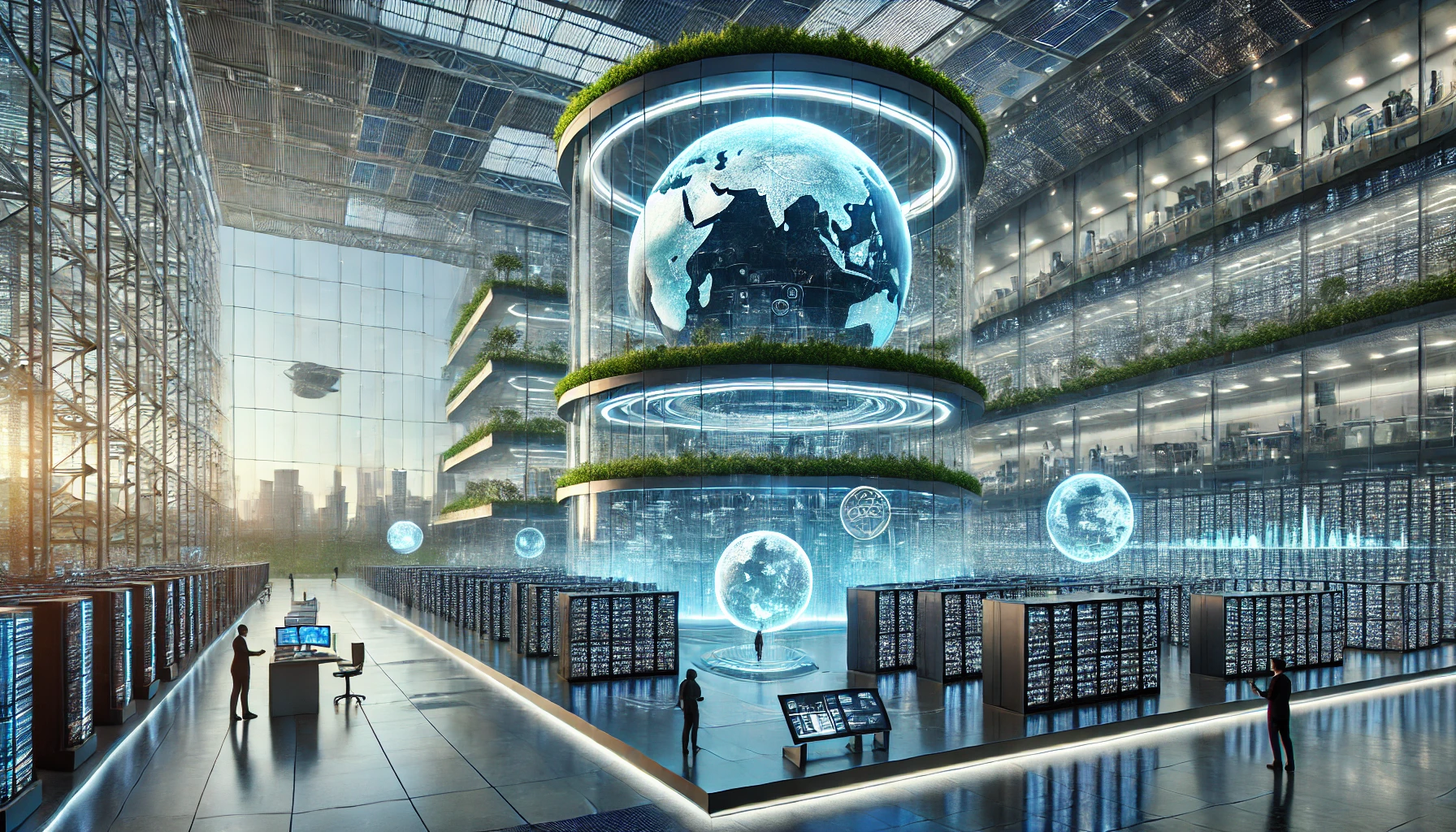

Support/Suggestions Email:
earthintelligence@earthintel.news




